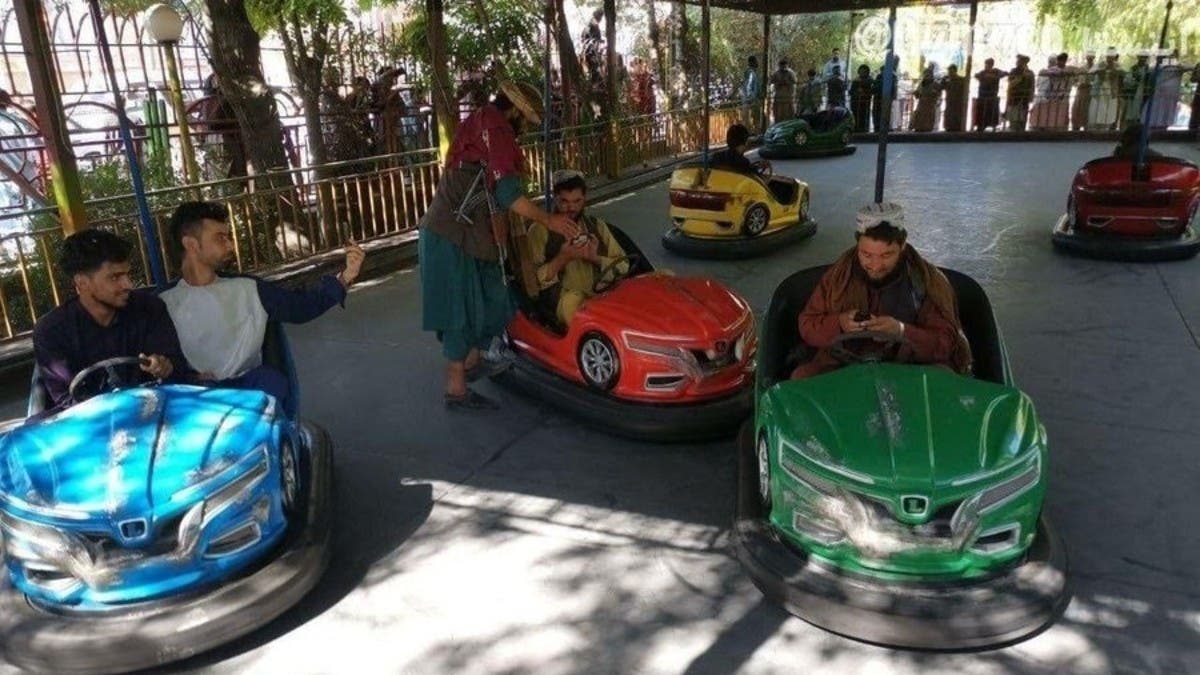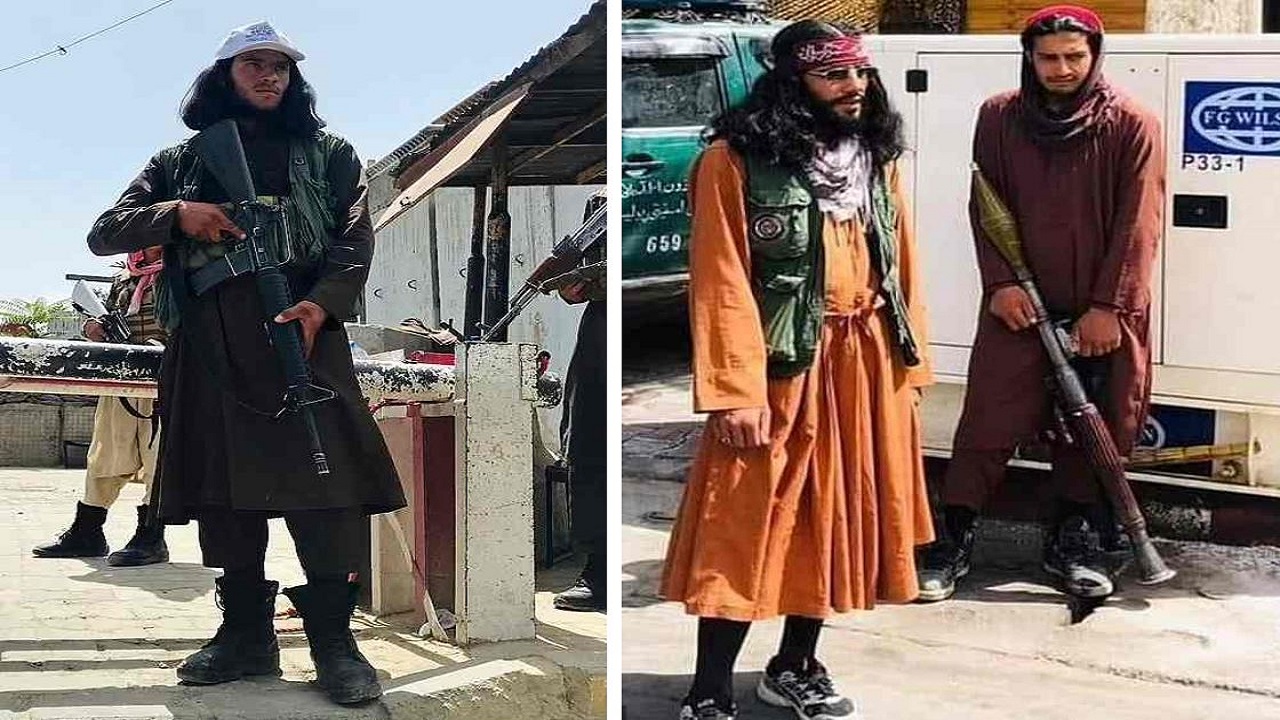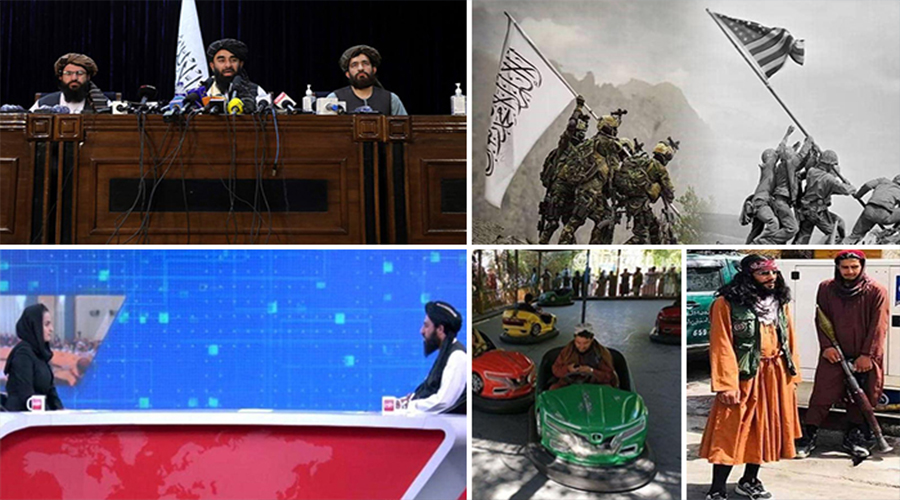20 years after the overthrow of the Taliban regime in Afghanistan, the movement has returned to seize control of the country. However, this time it is attempting to present itself in a different image from that of the nineties of the previous century in the hope of obtaining legitimacy and international recognition of the movement in ruling Afghanistan, and securing cooperation in the reconstruction of the country. For example, the Taliban replaced filming locations on the mountains with a studio on a satellite channel in front of a foreign anchor, emphasizing in its media discourse the rights of women and minorities, as well as publishing video clips of its fighters on social media as they lead a different lifestyle from what they are accustomed to and from that which is rooted in the movement.

Messages through the Media
The Taliban adopts a strategy based on intensive communication with the media, which is not only restricted to making statements and holding press conferences, but also extends to the coverage of unusual events such as the Taliban attending a football tournament and handing the cup to the winning team, or adopting methods that confirm their openness, such as the live call that surprised the anchor of Afghan origin, who had fled with her family and who sought refuge in Australia.
Social networks, specifically Twitter, have emerged as an active mediator in spreading Taliban messages inside and outside Afghanistan, specifically through the accounts of its spokesmen who write in English and Pashto, namely Zabiullah Mujahid, Qari Yousaf Ahmadi, Muhammad Naim, and Muhammad Suhail Shaheen.
This is not only on the official accounts of the movement, but social media networks are also an arena for the circulation of images and videos of Taliban fighters in a new form that soon occupied the top of the lists of popular content, where millions of people around the world watch and engage with them. Furthermore, what a Taliban member wears has become the talk of these sites, which provided a detailed description of the cost of his clothes, which exceeded $4,000, in a lifestyle that differs from the austere living that has been part of the image of the Afghan jihadist for years. Whether the content provided by the Taliban is official or not, it reflects a shift in the media strategy of the movement which used to smash televisions and ban the internet.

Pillars of the new Discourse
By analyzing the statements and press releases issued by the Taliban movement after its takeover of Afghanistan in mid-August 2021, 5 main statements may be identified as representing the pillars of the media discourse of the Taliban, as follows:
1- “Victory by war” not by negotiations:
The Taliban asserts that the US withdrawal from Afghanistan came due to the pressures of fighting against these forces over the past 20 years, saying: ‘There is no doubt that we won the war’, which is the source of the new legitimacy that the movement derives from the concept of ‘victory of the resistance’. In confirmation of that victory, the Taliban published a tape for the Special Operations Battalion, where in one of the clips fighters appeared in special forces uniform while raising the movement's flag, which mimics the famous US victory image "Iwo Jima" in World War II

2- Enforcement of an Islamic system that “considers the conditions of the people”:
Although the US, Russia, China and Pakistan announced their objection to establishing an Islamic Emirate in Afghanistan at a peace conference in Moscow on March 18, 2021, the Taliban has been confirming the establishment of an ‘authentic Islamic system that would be the best solution to all Afghans' problems’. The movement officially announced through the accounts of its spokesmen on Twitter the establishment of the Islamic Emirate of Afghanistan on the 102nd anniversary of independence from the British rule, only 4 days following the fall of Kabul.
However, the interpretation of what is ‘Islamic’ remains ambiguous. According to their description, in the ‘new Afghanistan’, the system of government will be Islamic “as appropriate to the situation of the country and taking into account the position and stability of the people”. Suhail Shaheen gave a very general answer when asked about the application of Islamic Hudood laws, saying that “everything that God Almighty commands us is our approach and a guide to our lives. We will not sell our religion, no matter what the temptations are, and we will not allow anyone to change the people’s creed or culture".
3- Openness for reform:
The Taliban movement has given reassuring messages abroad by emphasizing its openness to the world, and its pledge to China not to interfere in the issue of Uyghur Muslims, and not to allow the use of its lands against others, in reference to its previous hosting of Bin Laden, in addition to establishing an Afghan army made up of all sects and ethnicities. These assurances seem to be related to the Taliban's desire to attract foreign investment, particularly with its frequent talk about the reconstruction operations in Afghanistan.
4- Emphasis on respecting women’s rights:
The Taliban sent reassuring messages that women's rights would be respected within the framework of Islamic law, and that wearing the burqa is optional, with women obligated to wear at least a headscarf. It was also surprising for many when one of the movement's key officials, Mawlawi Abdul Haq Hamad, agreed to be interviewed by Beheshta Arghand, the Afghan anchor of Tolo News channel. This was the first time a Taliban official had done so in a television studio, which is a major transformation in the Taliban rules of media appearances.

However, this did not reassure people about respecting women's rights in Afghanistan, specifically after the Taliban enforced what it called ‘short-term measures’, which included obligating working women to stay at home temporarily until appropriate systems are set to ensure their safety, in addition to training security forces to deal with and talk to women in order to establish comprehensive security, which is unlikely to be achieved soon in light of the prevalent turmoil.
5- Conditional guarantee of freedom of media:
During the 20 years following the overthrow of the Taliban, dozens of media institutions have been active in Afghanistan, employing at least 8 news agencies, 52 television stations, 165 radio stations, and 190 publishing houses. This includes about 12,000 journalists, according to ‘Reporters Without Borders’. The ‘new Taliban’ quickly asserted that "the private media may continue to be free and independent, but it should not work against us", which reflects the ‘instrumental perspective’ of the media in serving the interests of the movement, which had previously shut down all media outlets in the 1990s except for Voice of Sharia Radio.
Three Dichotomies
In line with these statements, the Taliban’s media discourse is presented in three dichotomies, each of which gives the movement a distinct image as ‘serving the people,’ ‘fighting the occupier,’ and ‘desiring to coexist,’ without compromising the principles of Islam:
1- The Taliban against the forces within Afghanistan:
The movement portrays itself as the most powerful party that has seized control over all parts of Afghanistan despite the presence of hostile provinces. It also deals aggressively with its opponents and pardons anyone without retaliation in favor of Afghanistan. The Taliban also portrays themselves as offering a helping hand of providing security and safety to the Afghan people. The movement is concerned with the people's interests, and with preserving their cohesion and independence, certainly under its leadership.
2- The victorious Taliban against the West, specifically the US:
The Taliban are being portrayed as the resistance movement that forced Washington to withdraw from Afghanistan, amid warnings that any foreign forces remaining in the country past the deadline would be at risk of being considered an occupier
3- The Taliban and the world:
The movement seems willing to coexist peacefully and to cooperate with neighboring countries, most of which are connected to it with ‘relations that are not worrisome’. Despite the statement of Taliban leader Suhail Shaheen that "we do not have allies in the full sense of the word, neither are we members of any alliance or any military bloc," he described China as the main partner alongside Turkey. In reference to the latter, he also said that "the Islamic Emirate of Afghanistan needs its friendship, support and cooperation more than any other country”, which reflects an expanding future economic presence for Istanbul and Beijing.
Through these dichotomies, the Taliban are sending messages of reassurance and confirmation of dominance as well, through a discourse that presents a vague concept of the Islamic rule that the movement intends to enforce, as a temporary solution to avoid conflicts with internal parties or external fronts before things are settled for the Taliban. Meanwhile, this serves as reassurance for the international community in order to increase the movement's chances of international recognition and avoid the isolation which was the reason behind its fall in the 1990s. The movement appears to present a less hardline version consistent with what Suhail Shaheen called ‘experience, maturity, and insight, not creed’.
The Dilemma of Change
The Taliban seem to be in a real predicament, after exiting the phase of ‘fighting the invaders’ to ‘ruling the country’, amid doubts regarding the statements of its new discourse. There is major contradiction between the statements and some of what is actually happening on the ground. In view of the recorded clashes with the marches of civilians and the accusation of carrying out executions, there is one of two possibilities: either the movement presents a discourse to maneuver the global opinion, a discourse that contradicts its actual policies, or it is incapable of fully controlling its fighters who have been charged for many years with extremist ideas that cannot simply be undone, and that the movement’s leaders themselves believe that its members now need to be “reprogrammed” in order to be able to deal with a public life that includes women.
Change is inevitable for the Taliban, not only because of the transformations in its regional and international surroundings, and the experience it gained over 20 years on the ground and politically, but it is also due to the changes on the home front with the presence of a generation of young people who were born after the previous overthrow of the Taliban, and who grew up in a different and a more open regime. However, the movement is also in a dilemma about backing down from what it offered for years as “the Right Islam", and presenting a more pragmatic formula that might place it before dark possibilities of division and rebellion or the erosion of its support base.


